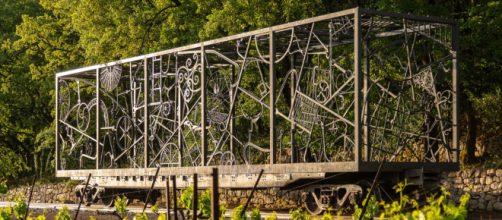“Perception and reality at the same time.” That’s the way legendary singer/songwriter Bob Dylan heralds his latest artwork – “Rail Car,” a life-size sculpture of a freight carriage – as if he were making some kind of art history.
Doesn’t he know that every painting, every sculpture, every artwork ever made comes with both “perception and reality”? It’s what you see and what you think or feel about what you see. It’s the art experience. Nothing noteworthy in that.
There’s also nothing noteworthy about this sculpture – “Rail Car” newly unveiled at the Art Center of Chateau la Coste in southeastern France.
What you see is a contour drawing in three dimensions, the lines made of a reported seven tons of iron. It’s a lot of nothing, even if it’s said to be the largest-ever sculpture of a freight carrier.
Please know, that I’m a longtime fan of Bob Dylan’s poetic songwriting ever since I saw him perform in Greenwich Village in the 1960s. But I can’t praise him this day. As if attempting to beef up the meaning of “Rail Car,” he told The Guardian that “all the iron is recontextualized to represent peace, serenity, and stillness.”
Words matter
Maybe I’m too weary of artists puffing up their work with press agentry. Dylan is better than that. He has long lyricized about trains, but never alluded to “peace, serenity, and stillness.” Just the opposite.
His song “Freight Train Blues” comes to mind. There’s nothing in the lyrics of how railroads make him feel secure, peaceful, serene, or still in any of the stanzas. Instead, his poem says that freight trains taught him how to cry. It’s hard to reconcile such sadness with his glittering generality about peace, serenity, and stillness.
None of this pan is meant to put Dylan’s interest in trains in doubt. They’re in his paintings, too. But whenever his feelings on the subject are in his songs, they’re sad, not serene.
Off the rails
In “Slow Train” consider his opening line: “Sometimes I feel so low-down and disgusted.” Then, to amplify his sorry state of mind about trains, he goes on to lyricize how the iron rail car rolls through the years “with a firebox of hatred and a furnace full of fears.” All of which has his description of “Rail Car” come off as plain ol’ puffery.
Iron certainly seems to be his medium in sculpture, but the titles he gives them usually sound less hyped. For his first sculpture - a gate showing in 2013 at Halcyon Gallery in London, he dubbed it “Mood Swings.”
Dylan’s ironworks, benign as they are, even made headlines. In 2019, the U.S. State Department paid a reported $84,375 for one of the singer's gates at its embassy in Mozambique. Some thought the cost “excessive.” I didn’t.
Clearly, trains are Dylan’s main focus. Maybe “Rail Car” would come across as weightier if he didn’t try so hard to build it up.


